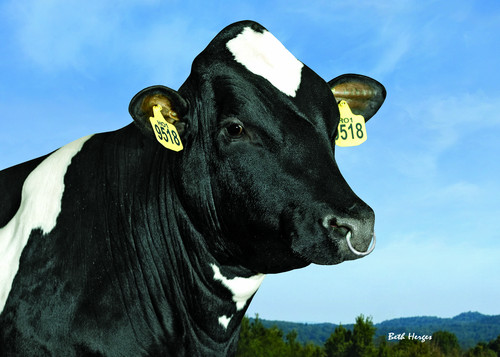What are polled cows?
The polled gene causes cows to be born without horns and is a dominant trait in cows. Additive traits (such as milk production) are those that are built up over time, where dominant and recessive traits are expressed or not – for example the red gene in Holsteins or eye colour in the human population.
The horned gene is recessive, meaning there needs to be two copies of the horned gene to breed a horned cow, but polled is dominant which means there only needs to be one copy of the polled gene to produce a hornless offspring, making them easier to breed.
There are two types of polled sires, heterozygous and homozygous. Heterozygous animals have one copy of the polled gene, and homozygous have two copies of the polled gene. Sometimes these are referred to as (P) and (PP).
Where did polled genetics come from?
Polled genetics isn’t a new phenomenon. We see evidence of polled cattle in U.S. dairy herds since the records began. The polled gene in the Holstein breed entered the U.S. with cows imported from the Netherlands in the latter part of the 1800s.
The polled gene has since spread throughout the US and Canada. However, they remain in low numbers within the Holstein breed, and are nowhere near as prevalent within the global dairy population as horned animals.
Polled cattle haven’t historically been selected within dairy strategies with farmers opting for traits that have a higher economic impact on their herds such as milk production, calf health or fertility.
This is very different to some beef breeds where polled is much more common. But are there, in fact, good reasons to include polled genetics as part of a breeding strategy today? And what impact might it have on the herd to select for this trait?
How is polled inherited in the dairy population?
With different types of sires, different types of matings are possible. When dairy farmers are selecting for particular traits as part of their genetic program, they can choose to produce polled cows in one of two ways.
Using a heterozygous (P) polled sire (a bull with one copy of the polled gene), with a horned cow will lead to a 50-50 split between polled and horned calves in the next generation. Using a homozygous (PP) polled sire with a horned cow will result in polled calves in every instance.
Benefits of polled genetics
- Advantage for dairy cattle – polled cattle don’t need to be dehorned, so will undergo a less stress during a crucial time for their growth and milk production.
- Benefit for the dairy producer – producing polled instead of horned cows will mean farms don’t have to expend the time, cost or labour of having to dehorn those cattle.
- Benefit for consumers – The truth is, consumers have a large influence in the way dairy farms operate, and people want to get their milk from cattle that are contented and well cared for. In some European countries this has included the integration of the polled gene into the national dairy herd, for example Germany. There has been a large amount of interest in Australia for polled genetics too. If your milk plant is willing to pay more for milk from polled cows due to welfare, then it may indeed be worth considering.
How can polled genetics be introduced into a dairy herd?
The answer to this question depends at least in part on the genetic strategy and herd management of a dairy herd, specifically on how fast the producer wants to move to a polled dairy herd and the overall genetic make-up of the desired offspring.
If producers choose heterozygous sires then half of the herd will move from horned to polled with the next generation. These calves will have a higher genetic level than those using homozygous animals, as they have fewer compromises.
However, if the desire is to move to a polled dairy herd quickly, homozygous sires will produce only polled cows. While the genetic level won’t be as high, the difference may not be as large as expected.






